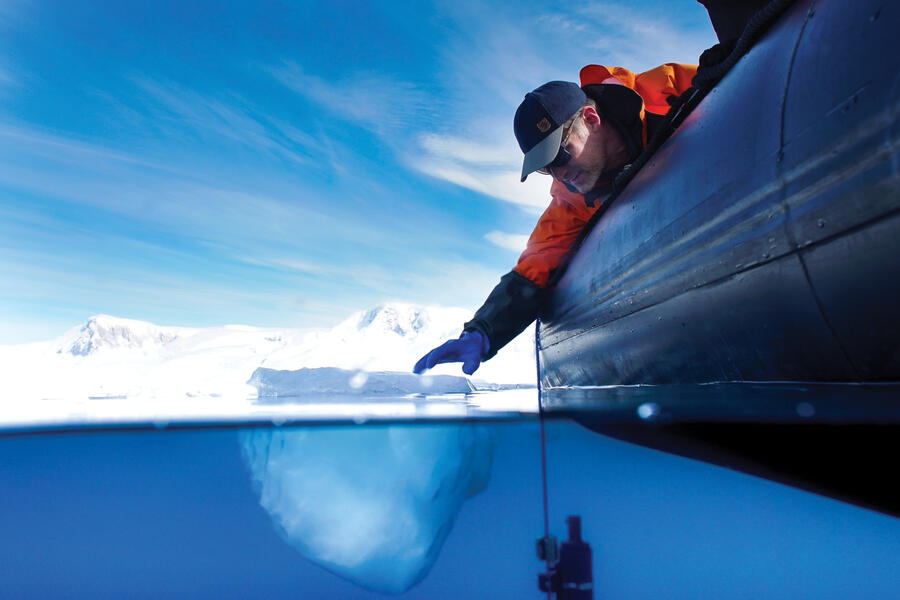Icebergs towered over molecular biologist Peter Thielen as he maneuvered an inflatable motorboat through a fjord on the western Antarctic Peninsula in early 2023. A senior scientist at Johns Hopkins University's Applied Physics Laboratory, Thielen was on a mission: collect eDNA to determine what species of whales and other mammals and organisms teemed beneath the undulating surface.
Environmental DNA, known simply as eDNA, refers to the genetic material shed by organisms in their surroundings. "Living creatures and organisms leave behind eDNA everywhere they go, whether in the form of cells, tissues, fluids, or excrement," Thielen says. Forensic scientists use human DNA to solve crimes. And now, biologists and engineers are devising cost-efficient ways to use eDNA for broad purposes, from monitoring wastewater, invasive species, and fish populations to improving shipping routes and protecting marine ecosystems.
"Currently, scientists collect eDNA from soil, water, and air samples," says Thielen, who has ventured to both ends of the Earth—the North Pole's Arctic Ocean and Antarctica's Southern Ocean—to test and fine-tune the novel research technologies and methods he and his team developed at APL. Their goal: use eDNA to capture snapshots of biological communities, without requiring expensive, complex equipment and technology. "Imagine a low-cost biological monitoring approach that industries, governments, and people outside of science could use, much like a point-of-care COVID test," Thielen says. That way, more groups could join the effort to catalog the number of species in a region and the places in which a species exists, uncovering some of the seemingly infinite unknowns of one of our planet's most vital resources: its oceans.
Essential to life on Earth, oceans produce more than half of the oxygen we breathe and absorb 60 times more carbon dioxide than our planet's atmosphere, yet much remains unknown about the zillions of organisms within its depths. "We don't even know how long whales live," owing in part to centuries of poaching, shipping strikes, and other factors that make whales an endangered or vulnerable species, Thielen says. Further, scientists estimate that 94% of life on Earth exists below water. But only 9% of marine species have been identified, despite a major effort in 2010, the Census of Marine Life, with 2,700 scientists from around the world working to document the oceans' unfathomable bounty.
Advances in technology, such as the methods Thielen is developing with engineers at APL, can make all the difference, he says. To put the new systems to a test, Thielen and marine biologist Hayley DeHart, a genomics research scientist at APL, made separate trips to both the North Pole and the South Pole. "A huge amount of marine mammal biodiversity exists at the poles, with some species living in both environments and others living only in the Arctic or Antarctic," DeHart says. "These unique environments make ideal test beds for refining and simplifying how we extract information from eDNA left behind in the water."
Also see
DeHart and Thielen traveled on ecotourism ships designed to traverse polar waters, including the National Geographic Resolution and National Geographic Endurance. With a program for visiting scientists, the APL team established an eDNA field laboratory with instruments to conduct proof-of-concept experiments—specifically, "to test and understand how well the tools we've created at APL work in the ocean environment, where research logistics are challenging and trained personnel are scarce," Thielen says.
One example, he says, is the small handheld eDNA filtration pump the team created, "which is as simple as putting a filter on the end of a piece of tubing and hitting a button to retrieve a biological sample." Essentially, the device collects biological materials from the water, leaving only a small filter to take back to the laboratory. Samples are then analyzed in each ship's field laboratory or returned to APL for more comprehensive study. This process eliminates many steps in the current eDNA analysis process, "where an expert would typically haul water back to the lab for filtration, and then process it using complex molecular biology steps to prepare it for DNA sequencing," he explains.
Back at APL, Thielen and his colleagues are developing tools to analyze eDNA data in near-real time, compare it with existing genetic references (if such data exists), and present the information in an easy-to-interpret manner. "We've created open-source software packages so the data can be distributed as broadly as possible," he says. Their long-term goal, however, is to remove the need to send the genetic samples to a lab altogether. "We have computer science–savvy people who can analyze eDNA data once it comes off the DNA sequencer, but getting it from a cup of water to data is still a hands-on process," Thielen says.
"Our newest capabilities aim to automate that process and make eDNA analysis as accessible as possible." That way, governments, commercial entities, nonprofit organizations, community groups, and even citizen scientists could start using eDNA to make data-based decisions.
During a recent talk in Austin, Texas, at South by Southwest, the combined conference-festival that attracts innovators in music, film, technology, and business (among other fields), Thielen pitched the plethora of practical applications. "We have ships coming in and out of our ports to deliver goods and services, and [invasive species] bind themselves to the hulls," he told the SXSW audience. "This slows ships down, causes their emissions to increase, and [leads to] all kinds of cascading effects." Knowing more about the biological communities on ship hulls could lead to better mitigation strategies and antifouling technologies designed to prevent the buildup of marine organisms.
Similarly, eDNA analysis could cut costs for the fishing industry, while helping to prevent declines in fish stocks that stem from rising temperatures, overfishing, and pollution, Thielen told the crowd. Until now, the best means of assessing fish populations have involved ships and nets.
"There's a much better way," he told SXSW. "All it takes a cup of seawater."
Posted in Science+Technology
Tagged genomics, apl, marine biology








